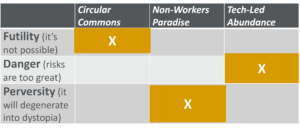I really enjoyed the excellent work of Rutger Bregman on utopias (reviewed here). Let’s focus on his point on how utopias are “attacked” in terms of our three positive images. These points could be thought of as tests that a utopia/image has to pass:
- futility (it’s not possible)
- danger (the risks are too great)
- and perversity (it will degenerate into dystopia).
They seem to be in order. That is, if you don’t pass the futility test, you don’t even get to the other two. While the criteria do or have all applied at some point to each our After Capitalism images, I thought it would be most interesting to think about which test would be the most difficult for each image to pass.
First a brief refresher on our three images:
- Circular Commons. Expands the concept of sustainability to embrace circular principles as part of a social, political, and economic commons.
- Non-Workers Paradise. A play on the attributed-to-Marxist idea of a worker’s paradise, but in the After Capitalism world we are not working in paid jobs as a means of sustenance.
- Tech-Led Abundance. Technological progress drives and leads to an abundance of wealth that fixes core distribution problem of capitalism
Of the three, I think the Circular Commons image is perhaps the least developed, and if presented to a representative sample audience, would probably generate the most skepticism about pulling it off. The circular aspect has some “brand recognition” and I think most would see that as not futile, but the commons part would likely be a different story. I think we can expect a great deal of resistance there, especially if that effort gets branded as a new version of the boogeyman communism, which is quite plausible.
most skepticism about pulling it off. The circular aspect has some “brand recognition” and I think most would see that as not futile, but the commons part would likely be a different story. I think we can expect a great deal of resistance there, especially if that effort gets branded as a new version of the boogeyman communism, which is quite plausible.
The Non-Workers Paradise has gotten past the futility point. The discussion around UBI, even though it is far from representing agreement, has at least entered “polite society.” The fact that Andrew Wang ran for the Democratic Presidential nomination on the UBI plank is pretty amazing, given that a decade ago this idea would be have been dismissed as utter lunacy. As discussed in the previous chapter however, there is a great fear that if people don’t have jobs they won’t know what to do with themselves, and most likely do bad things. I think we debunked that idea, but it is still strong and will likely be brought up if or as we move closer to this image.
Tech-Led Abundance is an interesting case. I think in this case we futures thinkers are perhaps more aware of the danger than the public at-large. I think there is a vague fear of a Terminator-like future, but this is not based on any deep thinking but relying on the movies for one’s ideas about the future. Judging by the present, there is a little bit of hand-wringing about the danger of AI, but it is basically full speed ahead. Bostrom in particular highlights the danger or risk of superintelligence, which I think we should pay attention to, but I doubt that we will. — Andy Hines

Leave a Reply